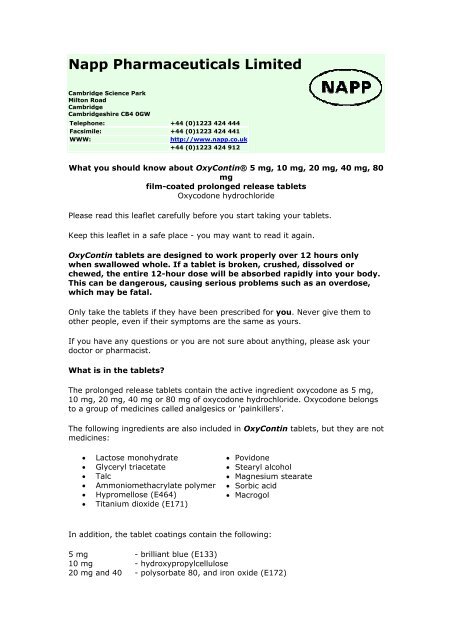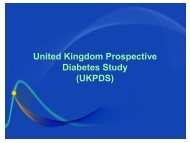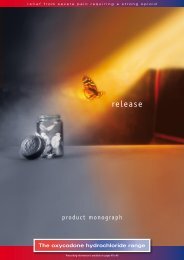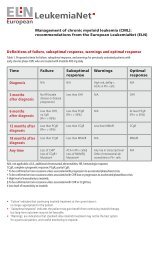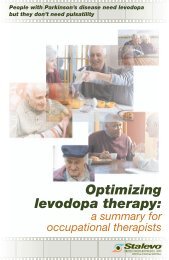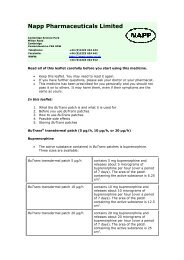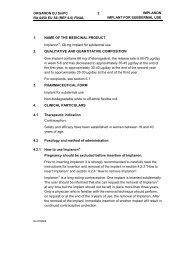Napp Pharmaceuticals Limited - epgonline.org
Napp Pharmaceuticals Limited - epgonline.org
Napp Pharmaceuticals Limited - epgonline.org
Create successful ePaper yourself
Turn your PDF publications into a flip-book with our unique Google optimized e-Paper software.
<strong>Napp</strong> <strong>Pharmaceuticals</strong> <strong>Limited</strong>Cambridge Science ParkMilton RoadCambridgeCambridgeshire CB4 0GWTelephone: +44 (0)1223 424 444Facsimile: +44 (0)1223 424 441WWW:http://www.napp.co.ukMedical Information facsimile: +44 (0)1223 424 912What you should know about OxyContin® 5 mg, 10 mg, 20 mg, 40 mg, 80mgfilm-coated prolonged release tabletsOxycodone hydrochloridePlease read this leaflet carefully before you start taking your tablets.Keep this leaflet in a safe place - you may want to read it again.OxyContin tablets are designed to work properly over 12 hours onlywhen swallowed whole. If a tablet is broken, crushed, dissolved orchewed, the entire 12-hour dose will be absorbed rapidly into your body.This can be dangerous, causing serious problems such as an overdose,which may be fatal.Only take the tablets if they have been prescribed for you. Never give them toother people, even if their symptoms are the same as yours.If you have any questions or you are not sure about anything, please ask yourdoctor or pharmacist.What is in the tablets?The prolonged release tablets contain the active ingredient oxycodone as 5 mg,10 mg, 20 mg, 40 mg or 80 mg of oxycodone hydrochloride. Oxycodone belongsto a group of medicines called analgesics or 'painkillers'.The following ingredients are also included in OxyContin tablets, but they are notmedicines:• Lactose monohydrate• Glyceryl triacetate• Talc• Ammoniomethacrylate polymer• Hypromellose (E464)• Titanium dioxide (E171)• Povidone• Stearyl alcohol• Magnesium stearate• Sorbic acid• MacrogolIn addition, the tablet coatings contain the following:5 mg - brilliant blue (E133)10 mg - hydroxypropylcellulose20 mg and 40 - polysorbate 80, and iron oxide (E172)
mg80 mg - hydroxypropylcellulose, iron oxide (E172), and indigo carmine(E132)In each box there are 28 or 56 tablets.The tablets are made by Bard <strong>Pharmaceuticals</strong> <strong>Limited</strong> for the marketingauthorisation holder <strong>Napp</strong> <strong>Pharmaceuticals</strong> <strong>Limited</strong>, both at Cambridge SciencePark, Milton Road, Cambridge CB4 0GW, UK.What are the tablets for?Your tablets have been prescribed to relieve moderate or severe pain, e.g. afteran operation, or to relieve severe persistent pain.Who can take the tablets?Adults over 18 years old can take the tablets. They are not recommended forchildren or adolescents under 18 years old.Do not take OxyContin tablets if:• you are pregnant or breast-feeding;• you are sensitive or allergic to oxycodone, or to any other ingredients inthe tablets;• you are taking monoamine oxidase inhibitors (MAOIs) or you have takenthis type of medicine in the last two weeks (you should know if you aretaking an MAOI as your doctor or pharmacist will have told you and youmay have a treatment card);• you have a bowel problem called paralytic ileus, or sharp and severe painin your abdomen;• you have had constipation over a long period;• you have a head injury that causes a severe headache or makes you feelsick, because the tablets may make these symptoms worse or cover upthe extent of the injury;• you have cor pulmonale (a heart problem after long-term lung disease).Also tell your doctor or pharmacist if you have any condition in the list below:• Problems with breathing properly.• An under-active thyroid (hypothyroidism), as you may need a lower doseof OxyContin tablets.• Poor adrenal gland function.• Kidney or liver problems, as you may need a lower dose of OxyContintablets.• Difficulty passing urine.• Pancreatitis (inflammation of the pancreas) or problems with your gallbladder.• Inflammatory bowel disease.• Low blood pressure, hypercarbia (high concentration of carbon dioxide inthe blood), or hypovolaemia (low blood volume).• Toxic psychosis (a major mental disorder as a result of an infection).• An addiction to alcohol or drugs, or a severe reaction to stopping alcohol(delirium tremens) or drugs.• An intolerance to some sugars (e.g. lactose).
If you take OxyContin tablets with some other medicines, the effect ofOxyContin tablets or the other medicine may be increased. Tell your doctor orpharmacist if:• you are taking medicines to help you sleep (for example tranquillisers,hypnotics or sedatives);• you are taking medicines to treat depression;• you are taking other strong analgesics or 'painkillers';• you are taking medicines to treat psychiatric or mental disorders;• you have recently been given an anaesthetic;• you are taking medicines to treat high blood pressure;• you have recently been given a muscle relaxant;• you are taking cimetidine (a medicine for ulcers, indigestion or heartburn);• you are taking quinidine (a medicine to treat a fast heart beat);• you are taking antifungal medicines (such as ketoconazole);• you are taking antibiotics (such as erythromycin).If you are going to have an operation, please tell the doctor at the hospital thatyou are taking these tablets.Drinking alcohol during your treatment with OxyContin tablets may make youdrowsy. If you are affected you should avoid drinking alcohol.OxyContin tablets may make you feel sleepy. If affected, you should not drive oruse machinery.How do I take my tablets?The label on your medicine will tell you how many tablets to take and how often.If you are not sure, ask your doctor or pharmacist. Do not take more tabletsthan the label tells you to.Swallow your tablets whole with water. Do not chew, crush or dissolve them.The usual starting dose for adults over 18 years old is one 10 mg tablet every 12hours. However, your doctor will prescribe the dose required to treat your pain.Children and adolescents under 18 years old should not take the tablets.You should take your tablets every 12 hours. For instance, if you take a tablet at8 o'clock in the morning, you should take your next tablet at 8 o'clock in theevening.You must only take OxyContin tablets by mouth. The tablets should never becrushed or injected as this may lead to serious side effects, which may be fatal.What should I do if I f<strong>org</strong>et to take my tablets?If you f<strong>org</strong>et to take your tablets, take your next dose as soon as you remember,unless it is almost time for your next dose, then go on as before.What should I do if someone accidentally swallows my tablets or I taketoo many?
Call your doctor or hospital straight away. In cases of overdose, the stomach mayneed to be washed out (gastric lavage) at hospital. People who have taken anoverdose may feel very drowsy and sick, and may have breathing difficultiesleading to unconsciousness or even death. An antidote can be given by injectionto reverse severe side effects.Will I have any problems?As well as benefits, all medicines occasionally have unwanted effects in somepatients. These are called side effects.Most people will have constipation when they take these tablets. Your doctor canprescribe a laxative to overcome this problem.You may feel sick or vomit (be sick) when you take your tablets. Your doctor canprescribe an anti-vomiting medicine if it causes problems.You may find that you cannot concentrate or that you feel more sleepy thannormal when you start taking your tablets or when your dose is increased. Thisshould wear off after a few days.Tell your doctor if you have:• a severe skin reaction;• an allergic reaction;• difficulty breathing;• a fit.Sometimes you may have:• a dry mouth or a loss of appetite;• diarrhoea;• heartburn;• pain in your stomach;• a headache;• confusion, nervousness or anxiety;• a feeling of weakness;• a feeling of faintness, especially on standing up;• dizziness.You may also have:• insomnia (inability to sleep) or abnormal thoughts or dreams;• twitching;• difficulty breathing or shortness of breath;• decreased cough reflex;• a rash or itchy skin;• sweating or chills.There are also a number of side effects that rarely happen. Do not be alarmed bythis list of possible events. If you notice these or any other problems while takingthese tablets, please tell your doctor. Some of these rare side effects can affectyour gut causing:• difficulty in swallowing;
• belching or flatulence (wind);• gastrointestinal disorders (e.g. upset stomach);• ileus (slowing of the bowel);• taste changes;• hiccups.Others may affect your central nervous system (your brain and major nerves)causing:• vertigo (problems of balance);• hallucinations or disorientation;• hypertonia (abnormal increase in muscle tone);• mood changes or depression;• a feeling of restlessness, excitement, or agitation;• tremors, seizures or a loss of muscle tone;• tolerance or dependence (reliance on the medicine);• loss of memory;• malaise (generally feeling unwell);• tingling or numbness in fingers or toes or impairment in the feeling oftouch;• speech disorder;• blurred vision, or miosis (constriction of pupils).Other rare side effects include:• difficulty in passing urine, impotence or decreased sexual drive, oramenorrhoea (absence of periods);• palpitations or irregular heart beat, low blood pressure, syncope (fainting),or vasodilation (widening of blood vessels);• dehydration or a feeling of thirst, or swelling, for example in the legs andankles;• dry skin, facial flushing (redness of the face), muscle spasm, or fever;• severe allergic reaction.Further information on taking or stopping your medicineDo not exceed the dose recommended by your doctor. There is a risk of addictionwith strong opioid painkillers. It is not known how often patients with painbecome addicted to strong painkillers, but the risk has been reported to be small.If during the treatment you find that oxycodone is not providing sufficient painrelief discuss this with him/her. You should not suddenly stop taking this medicineunless your doctor tells you to. If your doctor wants you to stop taking yourtablets he/she will tell you how to do this, usually reducing the dose gradually soyou do not experience unpleasant effects. If you want to stop taking your tablets,talk to your doctor.How should I keep my tablets and for how long?There is a 'use-by' date on the label. For example, EXP 8.2005 means that youshould not take the tablets after the end of August 2005. After the 'use-by' date,or if you have any unused tablets, take them to a pharmacy for safe disposal.Do not keep your tablets above 25°C. Keep them in a safe place where childrencannot see or reach them. Accidental overdose by a child is dangerous and maybe fatal.
Date this leaflet was written:February 2004OxyContin tablets are the subject of European Patents (UK) Numbers 0 253 104,0 576 643 and European Patent Application 96102992.3.® The NAPP device (logo) and OxyContin are Registered Trade Marks.© <strong>Napp</strong> <strong>Pharmaceuticals</strong> <strong>Limited</strong>, 2004.


